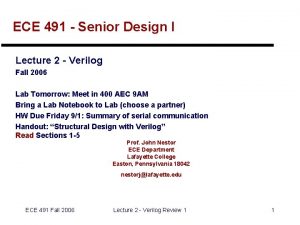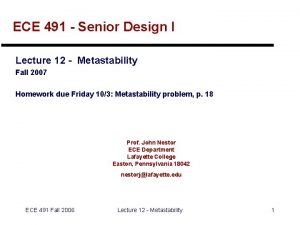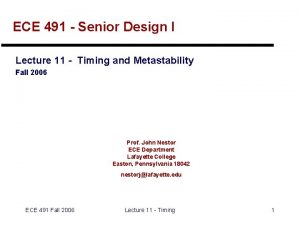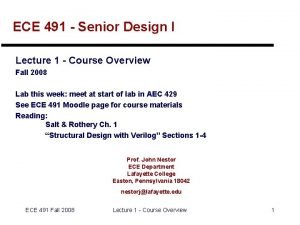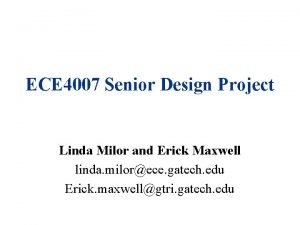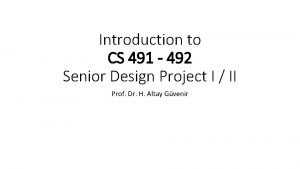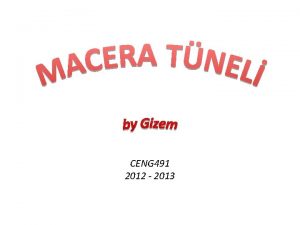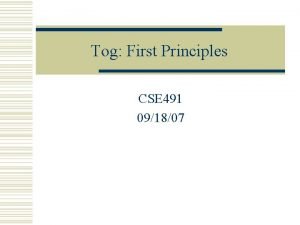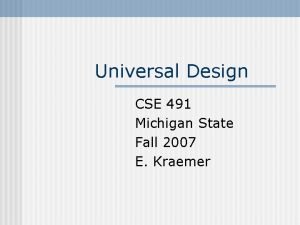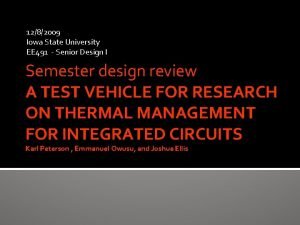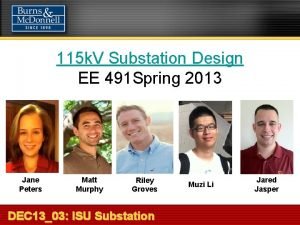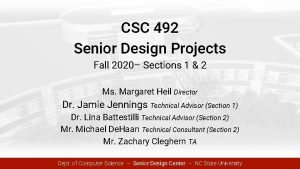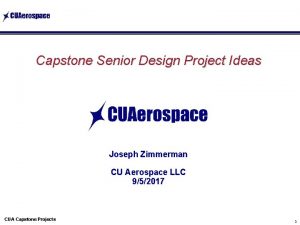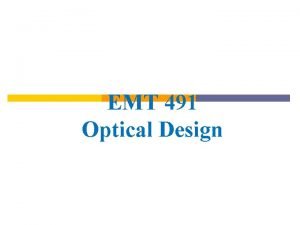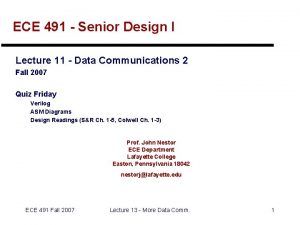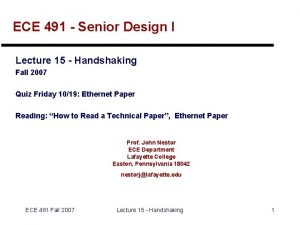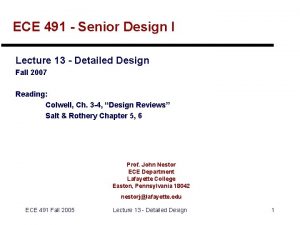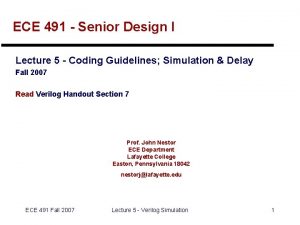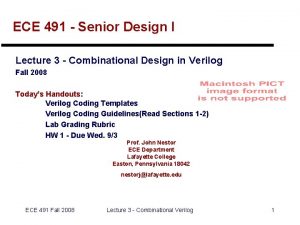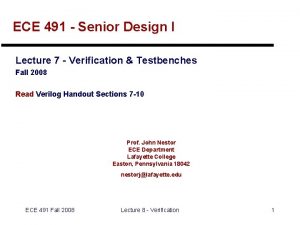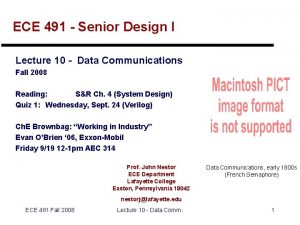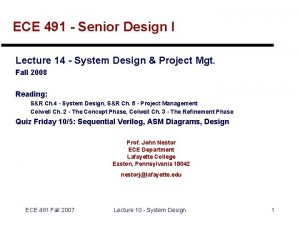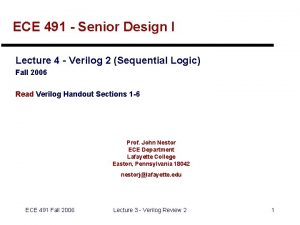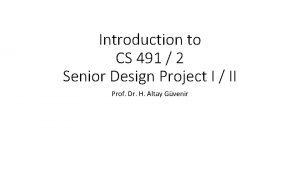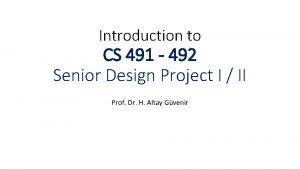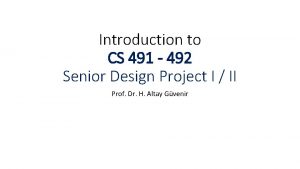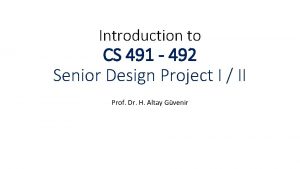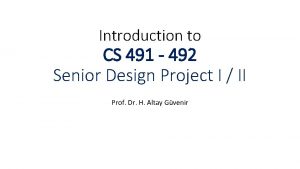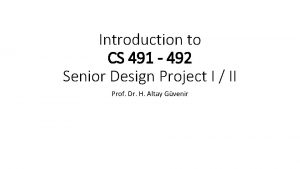ECE 491 Senior Design I Lecture 8 Requirements


























- Slides: 26

ECE 491 - Senior Design I Lecture 8 - Requirements Analysis Fall 2008 Read S&R Chapter 3. Requirements Analysis) Prof. John Nestor ECE Department Lafayette College Easton, Pennsylvania 18042 nestorj@lafayette. edu ECE 491 Fall 2008 Lecture 8 - Requirements 1

Today’s Outline } } } The Role of the Design Engineer The General Design Process The Book’s Design Methodology Colwell’s Design Methodology Requirements Analysis ECE 491 Fall 2008 Lecture 8 - Requirements 2

The Role of the Design Engineer } Three stakeholders in design } Customer - client or end user } Engineer - undertakes the design } Manufacturer - builds the design Engineer } Trends in product design } Concurrent engineering - involves Customer all stakeholders in design process from start S&R Figure 1. 1 } Contract manufacturing outsourcing of manufacturing } Shortened design times & product lifetimes ECE 491 Fall 2008 Lecture 8 - Requirements Manufacturer 3

The General Design Process } Synthesis generation of possible solutions } Analysis evaluation of possible solutions } Decision - choosing a solution Problem, symptom, or expression of need Problem definition including statement of desired outcome Synthesis of alternative solutions Analysis (perhaps including experimentation) Decision (selection of one solution) Solution ECE 491 Fall 2008 Lecture 8 - Requirements 4 S&R Figure 2. 1

A Design Methodology (from S&R) } Requirements analysis } Creating a detailed problem specification } Defining what is needed for completion } System Design } Determine “how problem will be solved” } Create a system specification that describes design at a functional level } Result: detailed spec, block diagrams } Detailed Design } Create designs for blocks in system design } Debug and verify individual blocks } System Integration and Test } Combine design blocks } Test complete system ECE 491 Fall 2008 Lecture 8 - Requirements Customer needing solution to a problem Requirements analysis System design Detailed design System Integration And Test Properly functioning system S&R Figure 2. 4 5

P 6 Design Methodology (Colwell) } Concept } Consider problem and brainstorm solutions } Small group of senior designers } Define terms for success, failure } Refinement } Weed out implausible solutions } Prioritize remaining solutions to focus effort } Choose one approach as plan-of-record Original problem or opportunity Concept Refinement } Realization } Implement design using best idea so far Realization } Production } Carry design into high-volume ECE 491 Fall 2008 Lecture 8 - Requirements Production Product available in volume 6

Requirements Analysis } Key Questions: } What exactly is the design to accomplish? } What is the problem that the design is to solve } How will stakeholders know when it is done? } Key Goals } Clarify, define, and quantify design objectives } Make key decisions in collaboration with customer } Verify that the project is worth undertaking ECE 491 Fall 2008 Lecture 8 - Requirements 7

� Requirements Analysis: the Context Requirements analysis System design Requirements Specification Detailed design System Integration And Test S&R Figure 3. 1 ECE 491 Fall 2008 Lecture 8 - Requirements 8

Developing a Requirements Spec. } Problem Statement } In language of customer } Non-technical } Non-quantifiable } Requirements Specification } Technical, qualified specification } Includes criteria for judging acceptability of design Customer needing a solution to a problem Assess needs Problem Statement Specify design requirements Requirements Specification S&R Figure 3. 4 ECE 491 Fall 2008 Lecture 8 - Requirements 9

“Real-World” Considerations Constraining factors Financial limitations Legal/Regulatory Restrictions Customer’s Needs Enabling factors Expertise (outside/in-house) Assess Needs Adherence to existing designs & manufacturing processes Other (similar) designs Basic Research Problem Statement S&R Figure 3. 5 ECE 491 Fall 2008 Lecture 8 - Requirements 10

Needs Assessment } Key idea: “Stating the Problem” } Desired attributes of Problem Statement } Non-technical - stated in language of the customer } Non-quantifiable - qualitative, specific dimensions not required } Complete - should cover all aspects that designer anticipates encountering during design } Specifiable - must be able to translate into a detailed specification ECE 491 Fall 2008 Lecture 8 - Requirements 11

Steps in Needs Assessment } } } } Question the customer Differentiate needs and wants Explore project boundaries Input/output analysis Preview user interface Survey design attributes Identify conflicting needs Prepare draft operations manual ECE 491 Fall 2008 Lecture 8 - Requirements 12

Needs Assessment according to Dilbert ECE 491 Fall 2008 Lecture 8 - Requirements 13

Translating Needs to Specifications } Key idea: “quantify design needs and state in technical terms } Desired attributes of the specification } Complete - all design needs are covered } Consistent - design needs independent of each other & don’t contradict } Methods for translating needs to specifications } Expert sources } Reverse engineering } Tests and experiments ECE 491 Fall 2008 Lecture 8 - Requirements 14

Specification - Typical Outline } } } } Overview Statement of Problem Operational Description (draft User Manual) Requirements Specification Design Deliverables Preliminary System Test Plan Implementation considerations } Service and maintenance } Manufacture } Attachments: studies, codes & standards ECE 491 Fall 2008 Lecture 8 - Requirements 15

Case Study - Douglas DC-3 Source: “The Letter that Changed the Way We Fly”, Invention and Technology, Fall 1988 ECE 491 Fall 2008 Lecture 8 - Requirements 16

Example - DC-3 “Problem Statement” Source: “The Letter that Changed the Way We Fly”, Invention and Technology, Fall 1988 ECE 491 Fall 2008 Lecture 8 - Requirements 17

TWA Airplane Requirements 1. Type: All metal trimotored monoplane preferred but combination structure or biplane would be considered. 2. Power: Three engines of 500 to 550 h. p. 3. Weight: Gross (maximum) 14, 200 lbs. 4. Weight allowance for radio and wing mail bins 360 lbs. 5. Weight allowance must also be made for complete instruments, night flying equipment, fuel capacity for cruising range of 1080 miles at 150 m. p. h. , crew of two, at least 12 passengers with comfortable seats and ample room, and the usual miscellaneous equipment carried on a passenger plane of this type. Payload should be at least 2, 500 lbs. with full equipment and fuel for maximum range. ECE 491 Fall 2008 Lecture 8 - Requirements 18

TWA Airplane Requirements (cont’d) 6. Performance Top speed sea level (minimum) Crusing speed sea level = 79% of top speed Landing speed not more than Rate of climb sea level (minimum) Service ceiling (minimum) Service celing anyy two engines 180 m. p. h. 140 m. p. h plus 65 m. p. h 1200 ft. p. s. 21000 ft. 10000 ft. The plane, fully loaded, must make satisfactory take-offs under good control at any TWA airport on any combination of two engines. ECE 491 Fall 2008 Lecture 8 - Requirements 19

Some New Plane Designs } Airbus A 380 -800 Capacity Cruise Speed Range Service Ceiling ECE 491 Fall 2008 } Boeing 787 -3 525 -853 561 mph 8, 200 nm 43, 000 ft Lecture 8 - Requirements Capacity Cruise Speed Range 290 -330 561 mph 2, 3003, 050 nm Service Ceiling 43, 000 ft 20

Case Study: The Intel P 6 Project } Initial assignment - June 1990: “Your job is to beat the P 5* chip by a factor of two using the same process technology. Any questions? ” } P 5 = Original Pentium Chip, released 1993 } P 6 = Pentium Pro, released 1995 (became Pentium II, Pentium III, Celeron, etc. ) Source: Bob Colwell, The Pentium Chronicles, Wiley, 2006 ECE 491 Fall 2008 Lecture 8 - Requirements 21

The Intel P 6 Project } Colwell: clear goals are essential for success } What constitutes success? } What constitutes failure? } P 6 Goals: } } Performance (“double the P 5”) Die size Power Dissipation Clock Frequency ECE 491 Fall 2008 Lecture 8 - Requirements 22

P 6 Project Context } The RISC vs. CISC debate - still undecided in 1990 } Intel’s Approach to Microprocessor Design } } Start a new “flagship” design from scratch Conceive microarchitecture & build a chip around it Produce flagship chip in relatively low volume “Proliferation” chips - migrate microarchitecture to new process technologies & refine } Aggressive technology (out of order execution) needed for project success ECE 491 Fall 2008 Lecture 8 - Requirements 23

P 6 Specification “Plan of Record” (POR) } Official response of team to product request by marketing & upper management } Contents include: } } Goals Schedules Headcount estimates Analysis of anticipated competitive products ECE 491 Fall 2008 Lecture 8 - Requirements 24

Plan of Record Development Process Marketing Requirements Document (MRD) Marketing needs & wants Management vision & direction Linear roadmap extrapolation Technical Vision Scars from Past Projects Think and argue (a lot) Financial Planning Recruitment Space Planning Computer Purchases Tool License ECE 491 Fall 2008 Product Implementation Plan (PIP) Marketing Foils POR Docs (Colwell Fig. 2. 1, p. 14) Lecture 8 - Requirements 25

Coming Up } Data Communications } Design Verification ECE 491 Fall 2008 Lecture 8 - Requirements 26
 Ece 491
Ece 491 Mttr formula
Mttr formula Ece 491
Ece 491 Ece 491
Ece 491 Ece senior design gatech
Ece senior design gatech 01:640:244 lecture notes - lecture 15: plat, idah, farad
01:640:244 lecture notes - lecture 15: plat, idah, farad Ba491
Ba491 Ba 491
Ba 491 Presidential decree 491
Presidential decree 491 Cs 491 bilkent
Cs 491 bilkent Bahri tokmak
Bahri tokmak Tog 491
Tog 491 Cse 491
Cse 491 Ee 491
Ee 491 Ee 491
Ee 491 Ucf senior design
Ucf senior design Ncsu csc senior design
Ncsu csc senior design Ee senior design project ideas
Ee senior design project ideas Eurocode reinforcement detailing
Eurocode reinforcement detailing Elemen urban design
Elemen urban design Elements of interior design ppt
Elements of interior design ppt Lecture hall acoustics
Lecture hall acoustics Game design lecture
Game design lecture Computer-aided drug design lecture notes
Computer-aided drug design lecture notes Cmos vlsi design lecture notes
Cmos vlsi design lecture notes Structural and decorative design
Structural and decorative design Requirements modeling in system analysis and design
Requirements modeling in system analysis and design
